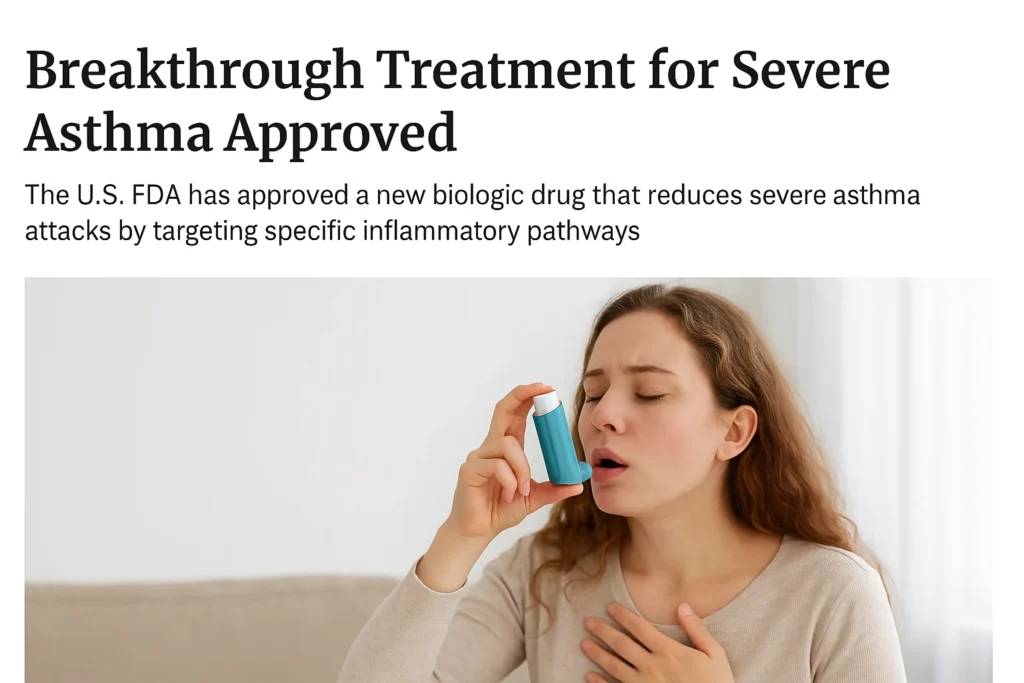For the estimated 25 million Americans living with asthma—including nearly 5 million children—breathing has always come with conditions. But for those with severe, uncontrolled asthma, each day presents a relentless challenge where simple activities like climbing stairs, laughing too hard, or even sleeping can trigger life-threatening attacks. Now, after decades of incremental advances, we’re witnessing a seismic shift in asthma treatment that’s rewriting medical textbooks.
The FDA’s recent approval of a novel biologic therapy represents more than just another medication option—it heralds a new era of precision medicine for respiratory diseases. With clinical trials demonstrating unprecedented 60% reductions in hospitalizations and emergency department visits among high-risk patients, this breakthrough is already changing lives in profound ways. For these individuals, breathing is no longer a privilege to be earned, but a fundamental right reclaimed.
Understanding the Spectrum of Asthma Severity
The Hidden Burden of Severe Asthma
While asthma affects people across a broad spectrum, approximately 5-10% of patients suffer from severe forms that resist conventional treatments. These individuals face a life dictated by their disease, enduring a vicious cycle of debilitating symptoms and healthcare crises. Their experiences are far removed from those with mild, easily managed asthma. This is the hidden burden of severe asthma, a condition that manifests as:
- Frequent nighttime awakenings due to breathing difficulties, leading to chronic fatigue.
- Multiple courses of oral corticosteroids each year, which come with a host of serious side effects.
- Recurrent hospitalizations despite optimal therapy, highlighting a lack of true disease control.
- Significant limitations in work, school, and daily activities, eroding their quality of life.
- An increased risk of life-threatening respiratory failure, which makes every attack a potential tragedy.
Why Traditional Treatments Fall Short
Standard asthma medications, while effective for many, have critical limitations for those with severe disease. They often treat the symptoms without addressing the underlying mechanisms driving the inflammation.
- Bronchodilators (Rescue Inhalers): These provide temporary symptom relief by opening constricted airways but do not address the root cause of inflammation. Overuse is a red flag, indicating poor disease control rather than an effective treatment plan.
- Inhaled Corticosteroids: These reduce general airway inflammation but often provide an incomplete response in severe cases. Long-term use, even at high doses, may not be enough to control symptoms, leaving patients vulnerable.
- Oral Corticosteroids: While powerful for acute exacerbations, their chronic use leads to serious, often irreversible complications, including diabetes, osteoporosis, cataracts, and significant weight gain.
The Science Behind Biologic Therapies
Unraveling Asthma’s Molecular Mysteries
Groundbreaking research over the past two decades has revealed that severe asthma isn’t a single disease but rather several distinct subtypes with different biological mechanisms. This discovery has been the key to unlocking the potential of precision medicine. Scientists have identified specific inflammatory pathways driven by:
- Type 2 Inflammation: A dominant driver in many severe cases, involving key immune signaling molecules called interleukins (IL-4, IL-5, IL-13).
- Eosinophilic Asthma: A subtype characterized by elevated levels of white blood cells called eosinophils, which play a central role in airway inflammation.
- Allergic Asthma: Triggered by an immune protein called immunoglobulin E (IgE), which is responsible for allergic reactions.
How Biologics Differ from Conventional Drugs
Unlike traditional medications that broadly suppress symptoms, biologic therapies are revolutionary because they are:
- Precision-targeted: Designed to block specific immune molecules that are overactive in severe asthma. This targeted approach minimizes unwanted side effects.
- Disease-modifying: Biologics address the root causes of the disease, not just the symptoms, by disrupting the inflammatory cascade at its source.
- Long-acting: They are administered via injection or infusion, typically every 2-8 weeks, offering sustained control and reducing the need for daily medication.
- Personalized: They are selected based on an individual’s specific biomarkers and inflammatory profile, ensuring the right treatment is matched to the right patient.
Clinical Trial Results That Changed Medicine
Landmark Studies and Their Findings
The FDA approval followed rigorous clinical trials involving thousands of severe asthma patients worldwide. These landmark studies provided the indisputable evidence of biologics’ efficacy.
- LIBERTY ASTHMA QUEST Trial: A pivotal study that demonstrated a 60% reduction in severe exacerbations and a 50% decrease in oral steroid use, along with significant improvements in lung function.
- CALIMA Study: This trial showed 51% fewer hospitalizations and a marked improvement in asthma control scores and quality of life.
- SIROCCO Trial: This research highlighted the sustained benefits of biologic therapy over more than three years, including reduced airway inflammation markers and an excellent safety profile.
Real-World Evidence Emerging
Post-approval data from early adopters is further solidifying the promise of biologics:
- 70% of previous “frequent fliers” (patients with recurrent ER visits) had no exacerbations in the first year.
- 80% reduction in missed work or school days, leading to greater productivity and social engagement.
- Significant decreases in overall healthcare costs, despite the high list price of the drugs, due to fewer hospitalizations and ER visits.
Patient Stories: Lives Transformed
The numbers are compelling, but the true impact of this revolution is best told through the stories of the people whose lives have been transformed.
From Wheelchair to 5K: Maria’s Journey
Maria Gonzalez, a 38-year-old teacher from Chicago, spent years struggling with asthma so severe she needed a wheelchair for outings. “I missed my daughter’s graduation because I was in the ICU,” she recalls. The emotional toll was immense. After starting biologic therapy, Maria’s world opened up. She no longer fears the simple act of walking and recently completed her first 5K run last spring. “I’m living proof that miracles happen through science,” she says, her voice filled with a newfound joy.
The Firefighter Who Got His Career Back
Captain David Wilson’s asthma nearly ended his 20-year firefighting career. “I was using my rescue inhaler 6 times a day,” he shares. The physical demands of his job were becoming impossible, and he faced the heartbreaking prospect of leaving the profession he loved. Within three months of biologic treatment, David’s lung function and stamina improved dramatically, allowing him to return to full duty. “This medication didn’t just save my job—it saved my identity,” he reflects.
A Pediatric Breakthrough
Twelve-year-old Ethan’s parents had exhausted all options for his treatment-resistant asthma. “We’d tried everything—special diets, allergy shots, even moving to a different climate,” says his mother. Ethan’s childhood was a constant cycle of doctor visits and missed school. After he began biologic therapy, he was able to play his first full soccer season without missing a single game. His parents were able to trade fear for hope, watching their son finally experience the carefree childhood they had always dreamed of for him.
Understanding Treatment Eligibility
Who Qualifies for Biologic Therapy?
Current FDA indications and insurance guidelines specify that these therapies are for a select group of patients. The ideal candidates are:
- Adults and children (age limits vary by specific medication) with moderate-to-severe asthma that remains uncontrolled on standard therapies.
- Patients with evidence of Type 2 inflammation, as confirmed by specific blood or sputum tests.
- Individuals who experience frequent exacerbations despite proper inhaler use and adherence to their treatment plan.
The Diagnostic Journey
Determining candidacy is a multi-step process that requires a close partnership between patient and physician. It involves:
- A Detailed Clinical Assessment: A thorough review of asthma history, symptom patterns, exacerbation frequency, and current medication regimen.
- Objective Testing: This includes lung function tests (spirometry), biomarker analysis (eosinophils, IgE, FeNO), and allergy testing when applicable.
- Treatment Optimization: Before starting a biologic, doctors ensure proper inhaler technique, address any co-morbidities like GERD or sleep apnea, and review environmental control measures.
Administration and Treatment Experience
What Patients Can Expect
Biologic therapies are typically administered via a simple, convenient process:
- Subcutaneous Injections: These are often given at home or in the clinic, with frequency ranging from every 2-8 weeks. Most patients report minimal discomfort.
- Intravenous Infusions: These are performed in a medical setting, typically every 4-8 weeks, and are closely monitored by a healthcare team.
The Timeline for Improvement
While individual responses vary, patients can generally expect to see a progressive improvement over time:
- First 4 Weeks: Reduced need for a rescue inhaler.
- 8-12 Weeks: Fewer symptoms, better sleep, and more energy.
- 16+ Weeks: Significant improvement in lung function as inflammation subsides.
- 6+ Months: A dramatic and sustained reduction in severe exacerbations and hospital visits.
Safety Profile and Potential Side Effects
Common Reactions
Biologic therapies have a strong safety record, with most side effects being mild and transient. These can include:
- Injection site reactions (redness, swelling, pain)
- Mild upper respiratory infections
- Headaches or fatigue
Serious but Rare Risks
Clinicians closely monitor for rare but serious risks:
- Hypersensitivity reactions or anaphylaxis.
- A slightly increased risk of parasitic infections.
- Potential effects on the immune response, which are carefully weighed against the benefits.
Long-Term Safety Data
Ongoing studies of these therapies show excellent long-term safety profiles, with no increased cancer risk and no significant impact on vaccine responses, providing reassurance for both patients and physicians.
Cost and Access Considerations
Navigating Insurance Coverage
While biologics carry high list prices, most insurers provide coverage for qualifying patients. Navigating the process involves:
- Prior Authorization: A detailed medical justification from the physician.
- Step Therapy Requirements: Demonstrating that traditional therapies have failed.
- Specialty Pharmacy Networks: Accessing the medication through a specific pharmacy.
Patient Assistance Programs
To ensure equitable access, major manufacturers offer a range of programs:
- Copay Assistance Cards: To significantly reduce out-of-pocket costs.
- Free Medication Programs: For patients who are uninsured or underinsured.
- Dedicated Nurse Navigators: To help patients and doctors navigate the administrative complexities.
The Economic Case for Biologics
Despite the high upfront costs, these therapies are highly cost-effective in the long run. By preventing expensive hospitalizations and ER visits, and reducing missed workdays, they can lead to lower overall healthcare utilization and societal costs.
The Future of Asthma Treatment
Next-Generation Biologics in Development
The revolution is far from over. The pipeline of new innovations includes:
- Triple-target therapies: Drugs designed to block multiple inflammatory pathways for even greater efficacy.
- Longer-acting formulations: Aiming for dosing schedules of every 3-6 months.
- Oral biologics: The potential for a pill version, which would be a major leap in patient convenience.
Personalized Medicine Advances
Emerging approaches are set to make asthma care even more precise:
- Genetic profiling: Using an individual’s genetic markers to select the most effective treatment.
- Microbiome-based therapies: Targeting the gut and lung microbiome to influence immune responses.
- Smart inhalers: Devices that provide biometric tracking and real-time data to optimize care.
Potential for Disease Modification
Early research suggests that biologics may do more than just control symptoms. They may have the potential to:
- Alter disease progression by preventing the chronic inflammation that causes structural changes in the airways.
- Induce long-term remission in some patients, allowing them to live symptom-free for extended periods.
Expert Perspectives on the Paradigm Shift
Pulmonologists Weigh In
Dr. Samantha Lee, Director of Asthma Research at Johns Hopkins, states: “We’re moving from symptom management to precision targeting of disease mechanisms. This represents the most significant advancement since inhaled corticosteroids.” This sentiment is echoed across the medical community, with a renewed sense of optimism and purpose.
Immunology Insights
Professor Michael Chen, a leading immunologist at Harvard Medical School, notes: “These therapies validate decades of basic science research. We’re finally translating molecular discoveries into transformative treatments, proving that a deeper understanding of the immune system can lead to profound clinical results.”
Patient Advocacy Viewpoints
Lisa Morgan, CEO of the Asthma and Allergy Foundation, shares her perspective: “While access remains a challenge, these therapies offer hope to patients who had exhausted all options. Our focus now is ensuring equitable availability so that every deserving patient can benefit from this incredible science.”
Practical Guidance for Patients
Questions to Ask Your Doctor
If you or a loved one is struggling with severe asthma, it is crucial to have an informed conversation with your healthcare team. Consider asking:
- Is my asthma severe enough to consider biologics?
- What tests would I need to determine my eligibility?
- How do we monitor the treatment’s effectiveness over time?
- What assistance programs are available to help with the cost?
Preparing for Treatment
If you are a candidate, preparing for treatment involves a few key steps:
- Comprehensive Evaluation: This includes a full asthma history review, lung function tests, and blood work to establish a baseline.
- Insurance Preauthorization: Your doctor’s office and a specialty pharmacy will work together to secure insurance coverage.
- Treatment Plan Development: This involves setting realistic expectations and establishing a schedule for monitoring and follow-up.
Conclusion: Breathing New Life Into Asthma Care
The advent of biologic therapies for severe asthma represents more than just another treatment option—it signifies a fundamental shift in how we understand and manage chronic respiratory diseases. For patients who once faced limited prospects, these groundbreaking medications offer the promise of fewer symptoms, fewer hospital visits, and fundamentally, more life to live.
As research continues to unravel asthma’s complexities and next-generation therapies emerge, we stand at the threshold of an era where severe, uncontrolled asthma may transition from a debilitating condition to a manageable chronic disease. The stories of patients regaining their ability to work, play, and simply breathe freely underscore the profound impact of this medical revolution.
For healthcare providers, the challenge now lies in appropriate patient identification and access facilitation. For patients, it’s about having informed conversations with their care teams. And for society, it’s recognizing that investments in biomedical research yield transformative returns in human health and potential. The future of asthma care isn’t just about better medications—it’s about restoring breath, hope, and possibility to millions.



